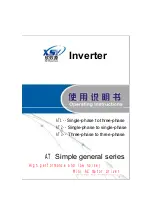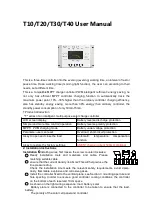
10
OPERATING INSTRUCTIONS
The
B+K Precision
Model 4011A Function Generator is a
versatile instrument, capable of producing a variety of output
waveforms over a broad range of frequencies. To gain a working
familiarity with the unit, it is recommended that it be connected
initially to an oscilloscope, so that the effects of the various controls
on the output waveforms can be observed. Use this manual as
required for reference until becoming accustomed to the operating
procedures.
FREQUENCY AND WAVEFORM SELECTION
l. Initially, verify that the
DUTY CYCLE
(14),
CMOS LEVEL
(13),
DC OFFSET
(12),
-20dB
(11) switches are in the OUT
position (released). This will produce a symmetrical waveform
unaffected by the other controls.
2. Plug the unit into an appropriate power source and turn it on by
engaging the
POWER
switch (1).
3. Select the desired waveform (SINE, SQUARE, or TRIANGLE)
by engaging one of the
FUNCTION
switches (3). Phase
relationships of the waveforms are shown in Fig. 2.
4. Select the frequency of the waveform by engaging one of the
RANGE
switches (2). The output frequency is displayed, along
with the appropriate measurement units, kHz or Hz (19), on the
LED display.
5. Rotate the
COARSE
(16) frequency control to quickly set the
output frequency to the approximate desired value. The
FINE
(15) frequency control can then be used to easily set the output
to the specific desired value. The frequency selected is available
at the
OUTPUT
jack (6). In addition, a digital signal, either TTL
or CMOS is available at the
TTL/CMOS
jack (7) (refer to the
“TTL/CMOS OUTPUT” section of this manual).
6. Adjust the amplitude of the output as desired using the
OUTPUT LEVEL
control (4). Rotation of this control
varies the amplitude from maximum to 20dB below
maximum. An additional attenuation of -20dB is
available by pushing in the
-20dB
switch (11). The
attenuation factors can be combined for a total of -40dB.
The maximum signal level is 10V p-p (into 50
Ω
).
Figure 2. Output Waveform and Phase Relationship











































